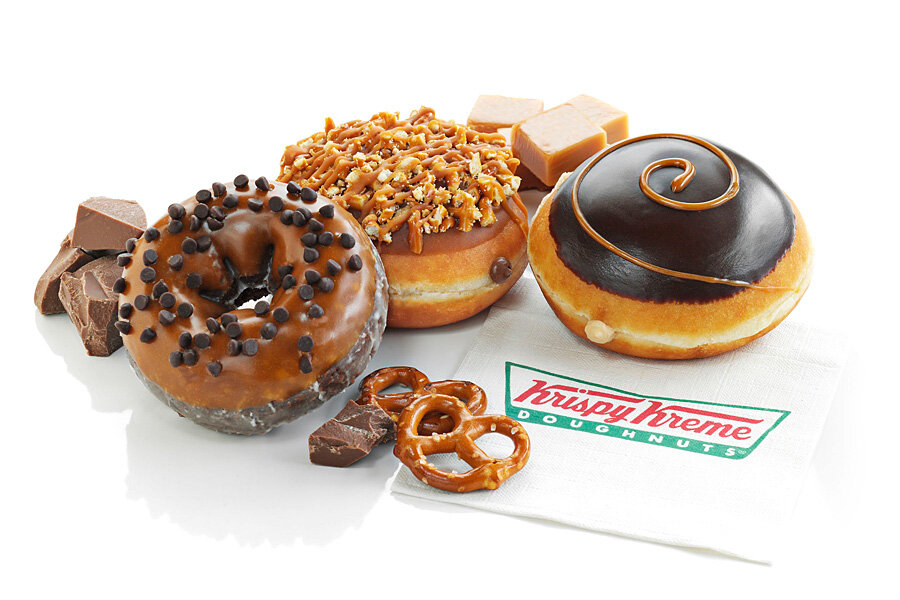Krispy Kreme sales down: Foreshadowing the donut's demise?
Loading...
The glorious fried dough confectionery that makes for a sugary breakfast treat has had its ups and downs amongst a rising trend in health foods and increased breakfast competition. Donut specializer Krispy Kreme appears particularly volatile, with prospects looking less than sweet.
On Thursday, the company reported quarterly sales and earnings that missed the mark, causing its stock to plummet 12 percent, reported CNN Money, a complete turnaround from the stock’s success in June that sent shares up nearly 17 percent. Overall, Krispy Kreme is down over 20 percent this year.
The chain has struggled with consumer packaged goods sales and is trying to focus on its in-store sales, opting for Starbucks’ limited-time offer model by offering select specialty donuts for higher prices.
However, this doesn’t seem to be tripping CEO Tony Thompson up, who actually revealed plans to expand and open more stores. And not just nationally. In a late August press release, Mr. Thompson announced plans to open ten stores in Myanmar (Burma), behind newly opened locations in India and Japan.
But what do the donut chain’s struggles say about the larger market? Are American consumers moving towards healthy options, or is there just too much competition in the breakfast market?
It may be a combination of the two.
There’s no question that the health food market is booming. "Super foods" such as kale and quinoa have exploded in the past few years. Quinoa, as a gluten-free grain, has jumped aboard multiple health trend trains. “Kale has seen a 400 percent increase in appearance on restaurant menus” since 2008, reported USA Today, with marketing schemes that seem to have succeeded in making “kale” synonymous with “healthy.”
Furthermore, the US Department of Agriculture (USDA) reported that organic product sales account for over four percent of total food sales and organic products are now available nearly three out of four conventional grocery stores.
This preference towards healthy choices seems to be highly dependent on consumer age.
According to a study conducted in January by USA Today, generation Z consumers, those younger than 20 years old, appear to be the most health conscious, two times as willing to pay more for healthier food products than those 50 years and older.
While this health-trend continues to grow and as restaurants seek to appeal to the younger generations, fast-food chains are trying their hand at “healthy.” Yet the health kick appears to be working better for some chains than for others.
Additionally, the majority of fast-food chains are focusing greater efforts on breakfast, seeing that the early morning hours may be their ticket to pulling ahead. “The NPD Group reported that breakfast has been the fast growing daypart, with a 4 percent increase in customer counts during the 12 months ended May 2015. No chain wants to lose its momentum in the mornings,” reported The Christian Science Monitor.
Dunkin’ Donuts, one of Krispy Kreme's prime competitors, offers both “indulgent products and DDSmart products,” says John Costello, president of global marketing and innovation at Dunkin’ Brands. DDSmart is Dunkin’s “better-for-you” menu options, offering lower calories “that keep you running,” according to the chain’s marketing campaigns.
“Two of our most successful products are the Big N’ Toasted, which is a big, hearty, fill-you-up breakfast sandwich, and our Turkey Sausage Breakfast Sandwich, which is a DD Smart, lower-calorie offering,” said Mr. Costello said in a June 2014 conference call. Apparently, customers want the best of both worlds.
Dunkin’ Donuts stock has has not seen the same weak results as Krispy Kreme this year and has actually risen 11 percent since January. Amid plans to unveil a delivery service and a 1,400-store expansion plan in China, Dunkin’ seems to be rolling.
McDonald’s is up just under 2 percent for the year, falling somewhere between its breakfast rivals. In a bid to appeal to health-conscious customers, McDonald’s announced a switch to cage-free eggs earlier this week. But stock prices didn’t seem to respond to the news, dropping a quarter of a percent.
Krispy Kreme, on the other hand, hasn’t experimented with healthier options, and has instead focused on its renowned donuts.
In June, following Krispy Kreme stock price increases, Business Insider’s Ashley Lutz wrote, “Krispy Kreme's booming business proves that the idea that modern consumers prefer healthier options is a myth.”







